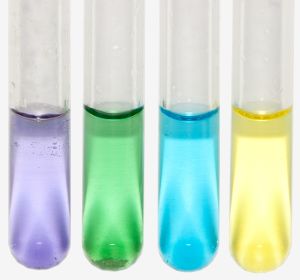Discovery of Vanadium
Dr. Doug Stewart
 Vanadium was discovered in 1801 by the Spanish scientist Andres Manuel del Rio.
Vanadium was discovered in 1801 by the Spanish scientist Andres Manuel del Rio.
Del Rio discovered the new element in brown lead ore (now known to be the mineral vanadinite, Pb5[VO4]3Cl) in New Spain (Mexico).
Del Rio had moved to Mexico as a professor of Chemistry and Mineralogy at the Royal School of Mines, Mexico City.
He named his new element panchromo or panchromium meaning ‘all of the colors’ because of the wide range of colors he had found when investigating the element’s salts.
He then renamed the element eritrono or erythronium, from the Greek word eruthros, meaning red. The new name was inspired by the red color which was seen when Group 1 or Group 2 oxide salts of the new element – for example sodium vanadium oxide – were heated or acidified. (1),(2),(3)
In 1805 the French chemist Hippolyte-Victor Collet-Descotils examined the lead ore and announced that erythronium was actually impure chromium – an analysis which, unfortunately, del Rio accepted.
Nothing more was heard of the element until 1830, when Nils Gabriel Sefström in Stockholm, Sweden, found a new metal in a Swedish iron ore.
He called this new element vanadium after ‘Vanadis’ the Scandinavian goddess of beauty because of the beautiful multicolored compounds formed by the metal. (4)
In the same year, German chemist Friedrich Wöhler reinvestigated the Mexican lead ore and found that vanadium was identical to del Rio’s erythronium. (5)
The metal was first isolated by Sir Henry E. Roscoe in 1867, in Manchester, England, by reducing vanadium chloride with hydrogen.
The vanadium mineral roscoelite was named in honor of Rocoe’s work. (4), (6)
Appearance and Characteristics
Harmful effects:
Although vanadium is an essential trace element for some creatures a number of its compounds are toxic.
Generally, the higher the oxidation state of vanadium, the more toxic the compound.
Characteristics:
Vanadium is a bright white, soft, ductile metal with good structural strength.
Vanadium is resistant to attack by alkalis, hydrochloric acid, sulfuric acid, and salt water.
When present in compounds, vanadium exists mostly in the oxidation state V.
The metal oxidizes in air at around 660 oC to the pentoxide (V2O5).
 Uses of Vanadium
Uses of Vanadium
The main use of vanadium is in alloys, especially with steel.
85% of all the vanadium produced goes into steel, 10% goes into alloys of titanium and 5% into all other uses. 7
A small amount of vanadium adds strength, toughness, and heat resistance.
It is usually added in the form of ferrovanadium, a vanadium-iron alloy.
Vanadium steel alloys are used in gears, axles and crankshafts.
Titanium-aluminum-vanadium alloy is used in jet engines and for high-speed aircraft.
Vanadium foil is used in cladding titanium to steel.
Vanadium-gallium tape is used in superconducting magnets.
Vanadium pentoxide is used in ceramics and as a catalyst for the production of sulfuric acid.
The first extensive industrial use of vanadium metal was over a century ago in the vanadium-steel alloy chassis of the Ford Model T car.
A 1908 advertisement for the Model T read, “Vanadium steel, the strongest, toughest and most enduring steel ever manufactured, is used throughout the entire car.”
Abundance and Isotopes
Abundance earth’s crust: 120 parts per million by weight, 50 parts per million by moles
Abundance solar system: 400 parts per billion by weight, 9 parts per billion by moles
Cost, pure: $220 per 100g
Cost, bulk: $2.70 per 100g
Source: Vanadium is not found free in nature but is found combined in about 65 different minerals. Vanadium is also found in bauxite and in fossil fuel deposits. Commercially, production of the metal is by calcium reduction of the pentoxide.
Isotopes: Vanadium has 18 isotopes whose half-lives are known, with mass numbers 43 to 60. Naturally occurring vanadium is a mixture of two isotopes, 50V and 51V with natural abundances of 0.2% and 99.7% respectively.
The information contained in this article and provided by VanadiumCorp is sourced from third-party content in the public domain and is for general information purposes only, with no representation, guarantees of completeness, warranty of any kind, express or implied regarding the accuracy, adequacy, validity, availability, completeness, usefulness or timeliness of any information contained within. Please also excuse any syntax as authors and reposted articles are sourced from global origins. UNDER NO CIRCUMSTANCE SHALL WE HAVE LIABILITY TO YOU FOR ANY LOSS OR DAMAGE OF ANY KIND INCURRED AS A RESULT OF THE USE OF THIS REPOSTED ARTICLE. THE USE OF THIS ARTICLE AND YOUR RELIANCE ON ANY INFORMATION CONTAINED HEREIN IS SOLELY AT YOUR OWN RISK. VANADIUMCORP ALSO ASSUMES NO RESPONSIBILITY OR LIABILITY FOR ANY ERRORS OR OMISSIONS IN THE CONTENT OF THIS ARTICLE.

This Post Has 0 Comments